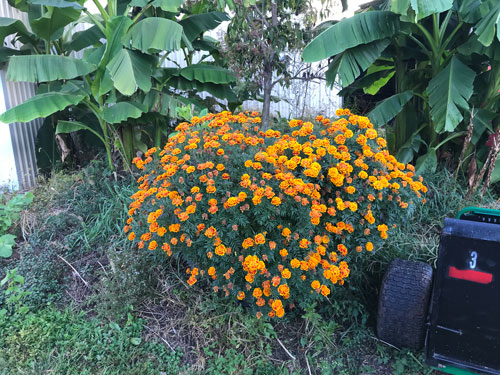7/1/2022
Marigolds in Fall?
Stanton Gill

Back when I started my career, Will Healy, who was an Extension Floriculture Specialist with the University of Maryland, dragged me along on a project to look for alternative plants for the horticulture industry for fall planting. Will was looking for a plant that could be added to the standard list of fall flowering crops, including chrysanthemums, pansy and ornamental cabbage and kale.
Pictured: A large planting of container-grown marigolds taken October 15, 2021.
He had the forward-thinking idea of using marigolds as a fall crop. For years, this group of flowering plants has been associated with summer-flowering plants. Actually, it turns out it does very nicely with the fall cooler weather and really comes into its own with outstanding flower displays in October. It stays in flower up to the first real hard frost.
In our trials, Will planted many different cultivars and I evaluated the plants for fall insects that might be potential problems on this crop as my part of the project. We found several excellent cultivars for fall flowering. We started plants in August and grew them to market size in late summer to early fall. We evaluated them from September through early November for two years. They looked great and thrived as the weather cooled in late September through October.
The trouble was this plant was associated by most people as a summer annual, not a fall crop. There really wasn’t a good audience willing to see this as a fall crop and we didn’t have a good marketing strategy.
It might be time to try this out again for late summer to fall plants. In India, the marigold, which is also called “genda,” is used for religious ceremonies and weddings. We have a growing population of people from India living in central Maryland. This audience may be more receptive to the idea of fall-blooming marigolds. Also, this audience could be explored to see if supplying marigolds for weddings has potential.
I asked my close friend Venkat, who’s from southern India, to comment on the demand for marigolds in India’s culture.
“One of my neighbors has this marigold plant in their backyard and the flowers are very beautiful,” he said. “Yes, Indians consume a lot of these flowers during religious ceremonies. This is very popular, as it is easy to transport and no worries that the petals will break, as it is a small flower.”
Venkat said that they use marigolds a lot during religious holidays, housewarmings and marriage ceremonies.
“At the Hindu temples, they use these flowers every day, and during the festival days, they consume a lot. They not only make garlands to wear around the neck, but they are also decorated around the main doors and pillars (almost like a Christmas lights decoration in a small way).”
Venkat also said there will be a huge demand to have bags of these flowers during the Dussehra festival and Diwali in grocery stores where there's a larger Indian population like in Ellicott City and Columbia, Maryland, and Ashburn, Virginia.
“Indians don’t prefer to have this flower in a bouquet, as these flowers are used to make garlands or keep on offering one flower at a time to God while chanting some Hindu prayers,” said Venkat. “If you Google ‘marigold flower In Indian festivals,’ there will be many pictures showing how they decorate.”
The Day of the Dead is another date for potential marigold sales. The Day of the Dead is a holiday celebrated on November 1 and 2. It originated and is mostly observed in Mexico. Marigold flowers are used extensively to honor ancestors. They lay down a chain of marigold flowers to guide dead ancestors to the altar.
Back to my part of this project, I found several western flower thrips in the flowers, but no real significant damage to the foliage of the plants. We actually started releasing the predacious mite, Amblyseius cucumeris, on the marigolds to serve as banker plants for thrips control on other crops. We also released Orius insidiosus (minute pirate bugs) on the marigolds, which served as excellent banker plants.
 Pictured: Day of the Dead celebration in Denver, Colorado, this past November.
Pictured: Day of the Dead celebration in Denver, Colorado, this past November.
One other observation: I have been recording pollinator activity on the marigolds in September and October, and the flowers are extremely popular and visited often by native bumblebee species. The plants could be marketed as an excellent source of nectar and pollen for pollinator activity in a landscape.
In a follow-up with Dr. Healy, who just recently retired from Ball Horticultural Company, the following comment adds to the marigold story:
“The garland marigolds is an interesting story,” said Will. “Burpee (a Ball company) had the first garland-type marigold (big head that lasts when not in water so it can be used in creating garlands). The garland marigolds are a really BIG deal in India to Vietnam. The markets in Thailand and India have a large number of stands with these available for sale in bags and in necklaces or ropes. They are used in religious and other ceremonial events (weddings).
“[Ball] stopped breeding these a long time ago and the breeding was continued by a couple of companies in Thailand and India. The leading breeder is Aga-Agro (a Ball Partner in Thailand). Very interesting company and people who run this company. Although they can use a number of different garden types for garlands, they just don’t hold up like the garland breeding.”
Will concluded by saying, “Talk about niche market when MILLIONS of flowers are sold every day is an understatement! If there is a Hindu and Buddhist population, there might be a market.”
So there is a market potential for the innovative grower. I think it’s time to look again at marigolds as a later summer/fall crop for the horticulture industry. GT
Stanton Gill is an Extension Specialist in IPM and Entomology at the University of Maryland Extension, and Central Maryland Research & Ed Center. He can be reached at Sgill@umd.edu.